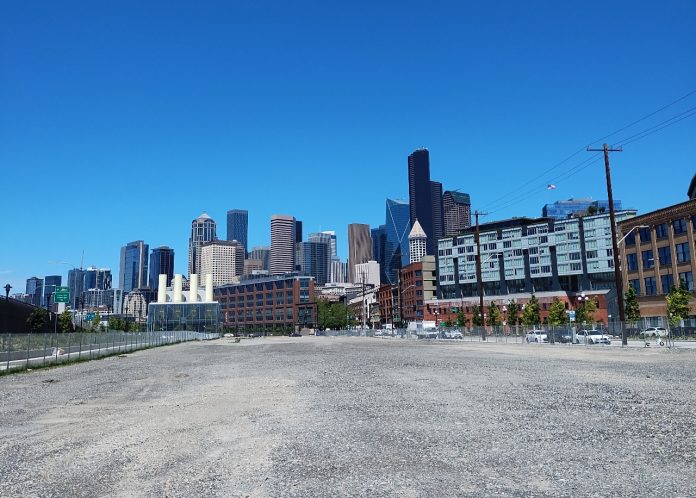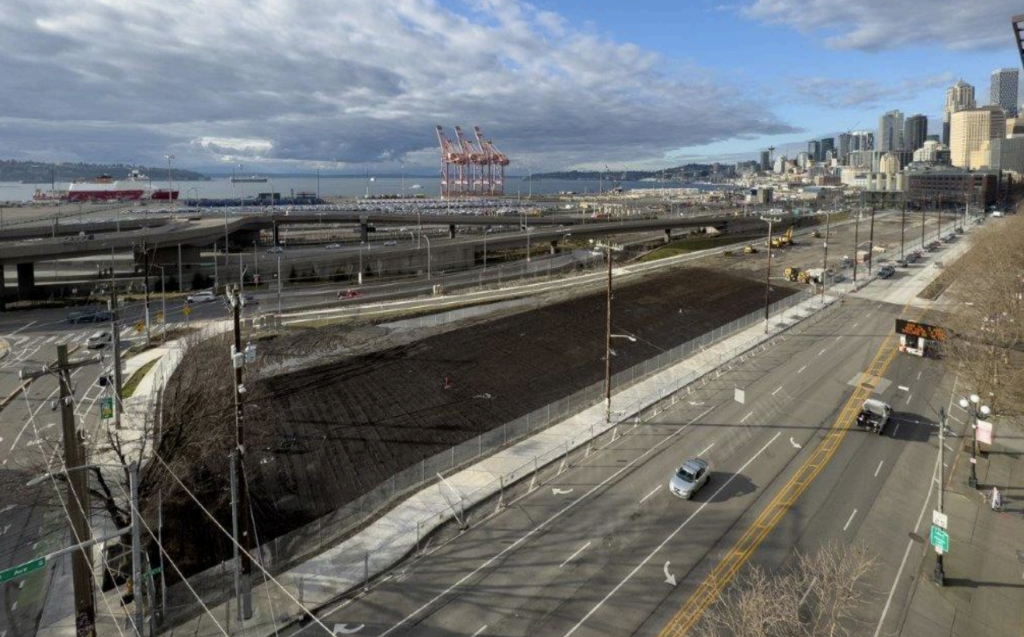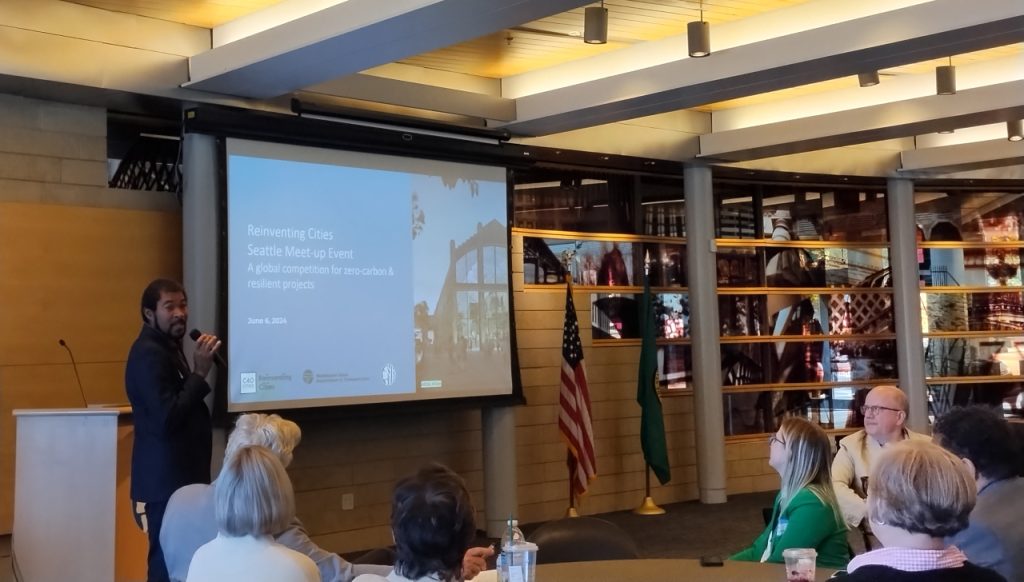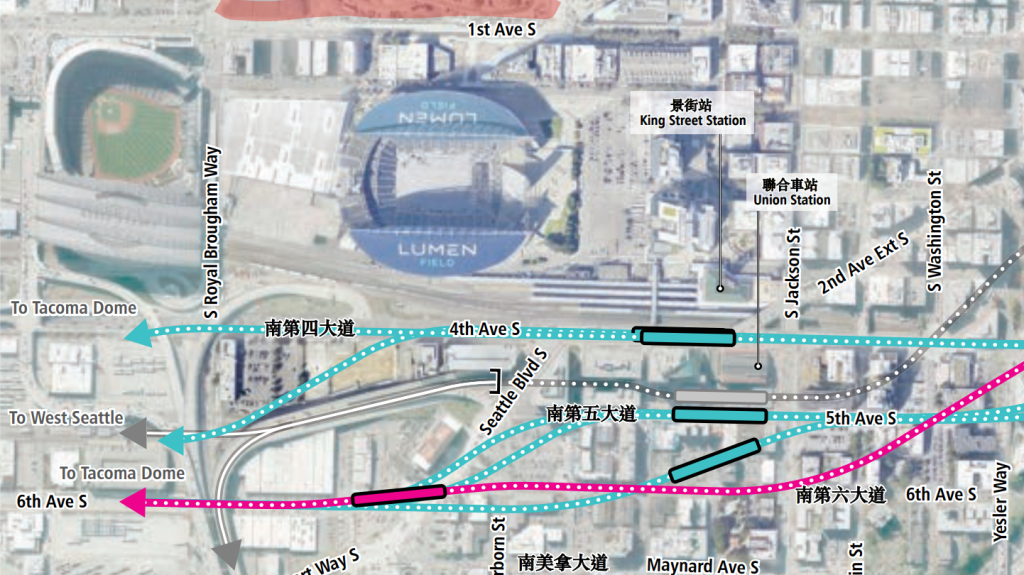
The generational opportunity to determine the fate of five acres of publicly owned downtown real estate is kicking off in earnest, and the process will reveal much about the future of Seattle and its urban core. A variety of competing interest groups are making it clear that they have a big stake in the outcome. The long-vacant plot is a stone’s throw from Lumen Field, with multiple government agencies attempting to thread the needle to achieve as many public goals as possible.
Situated along First Avenue S, the parcel is the former home of the Washington Oregon Shipper’s Cooperative Association (WOSCA), but was purchased over a decade ago by the Washington Department of Transportation (WSDOT) as a space to stage construction while the Alaskan Way Viaduct was replaced. Within the past few years, the remaining buildings on the site were demolished, leaving a fully vacant lot.

Earlier this year, WSDOT and the City of Seattle announced plans to solicit redevelopment concepts for the site, with the intention of selecting a firm to implement the winning bid. That work is now happening on an international stage with the help of C40 Cities, a climate-focused coalition of global cities which has developed a framework to redevelop major urban sites like this after successful implementation of a program like it in Paris, following the lead of Mayor Anne Hidalgo, C40’s former chair.
Just last week, the City of Seattle, along with C40 and WSDOT, hosted a meet-up event at the WOSCA site and at Seattle City Hall to discuss the project and field questions from potential applicants. A cadre of interested parties joined prospective firms at the event, including folks from the Port of Seattle, the Public Stadium Authority that oversees Lumen Field, and Pioneer Square and SoDo neighborhood groups. Groups sought more clarity around the vision for this unique parcel.
There are only a few baseline requirements: the site needs to ultimately include space for a new headquarters for Washington State Ferries. The final design also needs to include some elements that help to reduce climate impacts, and it needs to be constructed using green building standards. But the big question is how well the final proposal stitches together an extra-large superblock and helps to turn the area around Seattle’s sports stadiums into more of a real neighborhood rather than a pass-through for eventgoers.
The idea of holding a design competition to determine the future of the WOSCA site, rather than simply surplussing the land to the highest bidder, represents a new way of doing things for WSDOT. “We’re really excited for the opportunity to watch this parcel actually evolve into something maybe much, much bigger,” WSDOT deputy secretary Mike Gribner told the attendees at last week’s event. “It is the first for DOT to work with a program of C40’s caliber, I believe it is a first for us to work with the City. […] It’s certainly a first for the State of Washington as a whole.”
“If we wanted to turn this into a hotel, we would have gone with the status quo, which is to sell the property,” Anna Lising, senior policy advisor on energy for Governor Jay Inslee’s office, told attendees at the event. “That’s probably what we get the highest bid for, is turning [it into] a hotel.”

“We have a number of strategic priorities at the state, we have very ambitious climate commitments that we need to achieve. We’re not going to do that with just electrifying every vehicle,” Lising continued. “This is prime property downtown. We’re really interested in how do we build and use our land to be able to get mode shifting, how do we get people out of cars, how do we make sure that they have all the amenities and necessities within walking distance. We also have a housing shortage. There’s a number of high priority needs that we have in Washington state that we want to achieve, and show as a model, using this property.”
As Seattle struggles to return to pre-pandemic levels of activity downtown, the Harrell Administration said it sees the work on the WOSCA property as a central element of its downtown activation plan, and its strategy to activate and redevelop South Downtown, specifically. Harrell has advanced a last-minute proposal with King County Executive Dow Constantine to bypass the transit hub on Jackson Street as part of the Ballard Link Extension project and instead move forward with new light rail stations shifted to the south and north, with Sound Transit’s new preferred alternative just on the other side of Lumen Field from the WOSCA site.
In recent months, Sound Transit has tried to engage community members around what a “South Downtown hub” actually looks like, and the final use of the WOSCA site will be a major determinant in the area’s evolution.

Will the WOSCA site include housing? This is likely to be one of the most contentious issues to come up during the entire process. Just last year, the City of Seattle approved a new industrial land use framework that seemed to put to bed the issue of whether residential uses would start to extend further south from central downtown into the industrial district in SoDo. After pushback from industrial interests, including the Port of Seattle, the idea of rezoning to allow housing was largely rejected. But as part of any proposal for WOSCA, the City is set to approve a unique master plan that would override any underlying zoning restrictions, and open the door to residential use.
“When we did the industrial maritime strategy, and that the rezoning of our industrial lands, very much in partnership with labor unions and the Port, we specifically set aside this site for a future master planning process,” OPCD Director Rico Quirindongo told last week’s crowd. “When we did the rezone, we did that because we were going to come back and make changes at some later date, [but] we didn’t have a plan to do that — the C40 opportunity came to us.”
Even with a site as large as this, there won’t be enough room to make everyone happy, with many maritime and industrial advocates seeing the conversion of the site to residential or mixed use, even partially, as a loss for Seattle’s industrial sector and a symbolic attack on long-protected industrial lands. But commercial or industrial uses on the site likely do little to advance the stadium district, a clear bright spot for Seattle’s economic growth in the post-pandemic era, toward becoming a real neighborhood.
The International Longshore and Warehouse Union (ILWU) shared some skepticism in a stakeholder interview on the WOSCA project conducted in March: “We are aware that land use regulations recently passed by the City allow for a limited quantity of housing that is related to industry or is at least 50% workforce affordable in some areas. However, we are still concerned that any housing can have a big negative impact. And we are concerned that if any is let in there would only be additional future creep into more industrial areas.”
Though initial proposals are due by November of this year, it will likely be a long time before the WOSCA site’s future comes into full view, with applications initially shrouded from public view through non-disclosure agreements (NDAs). Meanwhile, Seattle is considering interim uses for the site during the 2026 FIFA World Cup, pushing the start construction on a permanent project to 2027 or 2028.
Even as the process takes place behind the scenes, WSDOT and the City are promising robust public engagement throughout, seeking the public buy-in that could be key to coming to a final consensus. In the end, whatever rises on the site will absolutely speak volumes for the future of the immediate area, but also downtown as a whole.
Ryan Packer lives in the Summit Slope neighborhood of Capitol Hill and has been writing for the The Urbanist since 2015. They report on multimodal transportation issues, #VisionZero, preservation, and local politics. They believe in using Seattle's history to help attain the vibrant, diverse city that we all wish to inhabit. Ryan's writing has appeared in Capitol Hill Seattle Blog, Bike Portland, and Seattle Bike Blog, where they also did a four-month stint as temporary editor.

